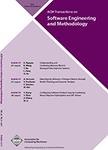版权所有:内蒙古大学图书馆 技术提供:维普资讯• 智图
内蒙古自治区呼和浩特市赛罕区大学西街235号 邮编: 010021

作者机构:Univ Naples Federico II Dept Elect Engn & Informat Technol Naples Italy Univ Maryland Dept Comp Sci Via Claudio 21 College Pk MD 20742 USA
出 版 物:《ACM TRANSACTIONS ON SOFTWARE ENGINEERING AND METHODOLOGY》 (美国计算机学会软件工程与方法论汇刊)
年 卷 期:2019年第28卷第3期
页 面:17-17页
核心收录:
学科分类:08[工学] 0835[工学-软件工程] 0812[工学-计算机科学与技术(可授工学、理学学位)]
主 题:Random testing saturation effect code coverage
摘 要:Random testing is a software testing technique through which programs are tested by generating and executing random inputs. Because of its unstructured nature, it is difficult to determine when to stop a random testing process. Faults may be missed if the process is stopped prematurely, and resources may be wasted if the process is run too long. In this article, we propose two promising termination criteria, All Equivalent (AEQ) and All Included in One (AIO), applicable to random testing. These criteria stop random testing once the process has reached a code-coverage-based saturation point after which additional testing effort is unlikely to provide additional effectiveness. We model and implement them in the context of a general random testing process composed of independent random testing sessions. Thirty-six experiments involving GUI testing and unit testing of Java applications have demonstrated that the AEQ criteria is generally able to stop the process when a code coverage equal or very near to the saturation level is reached, while AIO is able to stop the process earlier in cases it reaches the saturation level of coverage. In addition, the performance of the two criteria has been compared against other termination criteria adopted in the literature.